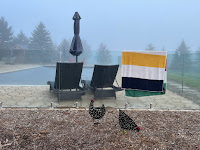21. Gerald Durrell, The Aye-Aye and I: A Rescue Journey to Save One of the World's Most Intriguing Creatures from Extinction (1992) (9/27/22)
 | |
| The copy I read has real character! |
The story involves Durrell and his team's quest to find six elusive aye-aye—the world's largest nocturnal primate, a two-foot-long lemur with rodent-like teeth that perpetually grow and a special-purpose, extra-long middle finger that it uses for foraging. Thought to be extinct in 1933, it was rediscovered in 1957, and since 1987 the Duke Lemur Center (DLC) has kept and bred aye-ayes. It is classified as endangered, although in the wild its numbers are probably higher than had been thought; it remains at risk because Malagasy people consider it evil, a harbinger of death, and so will kill it, and also because its forest homeland is being rapidly decimated.
Durrell's Jersey Wildlife Preservation Trust decided to join the DLC in keeping some breeding pairs of aye-ayes to help their chances of survival. Along the way they also collected some ploughshare tortoises, giant jumping rats, and bamboo lemurs of Lac Alaotra, for a full cargo load once their stay was done. But would they be able to find the six aye-ayes they needed?
The answer is delivered in Durrell's typically droll style, where he in passing describes markets, village dances, treacherous bridge and river crossings, strange foods, and the vagaries of local officialdom. The team's members come alive in all their quirkiness.
But his message is not all lightness. I marked two passages that resonated strongly with my own experience of this place, thirty years on.
This was one of the most depressing drives I have had in Madagascar. The road wound its way through miles and miles of beautiful hills which should have been covered with forest to act as watersheds, but each hillside was bare. Nothing but grass could be seen with red cicatrices of growing erosion showing glaringly. In the valleys around small villages we saw Ravenala palms, coconut palms, a few mango and lychee trees. Very occasionally, on the top of a hill we saw a pathetic little patch of original forest, like tufts of hair on the chin of a badly-shaved man. These remnants showed what the hills were clad in before the destruction. In places the raw, red earth had been cleared on such steep slopes that the soil, with no vegetation to hold it in pace, had no option but to slide into the valley, causing flash floods.
To the uninitiated eye, these hills looked pleasantly green and lush but in twenty or so years they would bring disaster for those that lived amongst them and endeavoured to obtain a living from the ever-decreasing soil. With no forests acting as the lungs of the hills and holding everything together in a web of roots, the soil was simply sliding away like sand in an hourglass. How can we persuade these charming, poverty-stricken people that slash-and-burn agriculture simply edges them and ultimately their children and grandchildren nearer to starvation? Even with millions of dollars, pounds, marks and yen, it would take hundreds of years to counteract the ravages that have been perpetuated on the land and replace the forest. It seems a terrifying and insoluble problem. . . .
You cannot blame the Malagasy people, but rather the people who have ruled in the past. To the peasant, the felling of a piece of forest is not looked upon as ecological suicide, but as a way of gaining a bit of soil that will give him a crop for a few years, while the forest he fells forms fuel for the fires that feed him. His forefathers did it, why should not he? He does not know that there are five times as many of him as there were in the grandfather's time and that this profligate use of nature's bounty will starve his grandchildren.
According to our guide, you can also blame the people who are ruling now: or rather, the corruption that rules this country. People are encouraged to clear the land to plant corn and peanuts, which are then exported to China—filling local functionaries' pockets into the bargain. And in a few short years, the land is spent.
This is one reason Durrell mounted his mission. The dire situation he was addressing continues. Already in the late 1980s he said that 90 percent of Madagascar's forests had disappeared. Although that figure appears to be inflated, it is predicted that all of the island's natural areas (with the exception of national parks, assuming they can be protected) will have disappeared within forty years. It is well and fine that animals like aye-ayes can live on in zoos around the world, but what a tragedy that their home, and the home of so many other unique and wonderful animals, is rapidly vanishing.
I enjoyed this book, and it made me sad. This is such a beautiful, amazing country. And I'm seeing only a remnant of what it was not so very long ago.




















